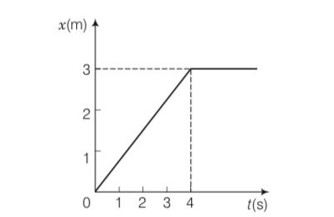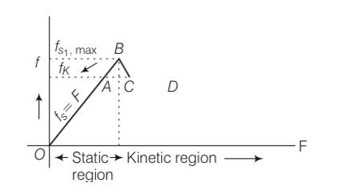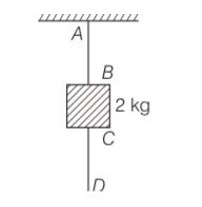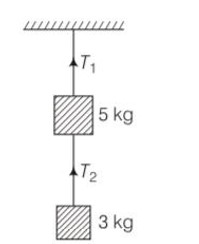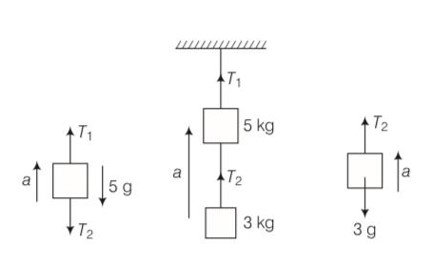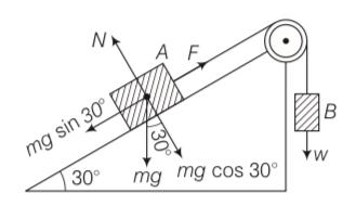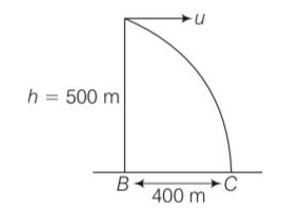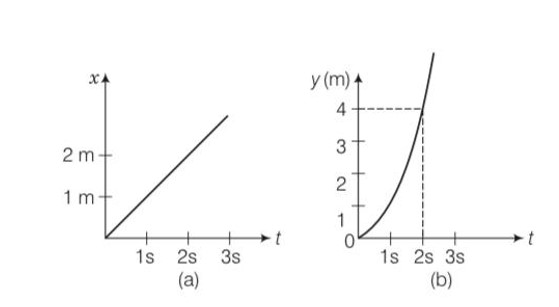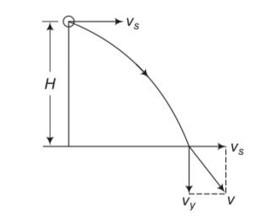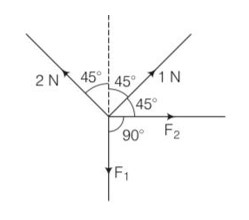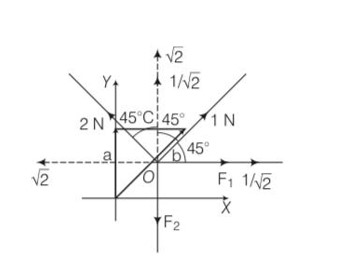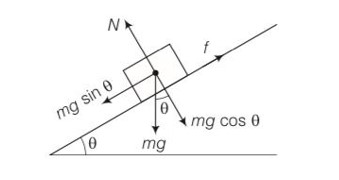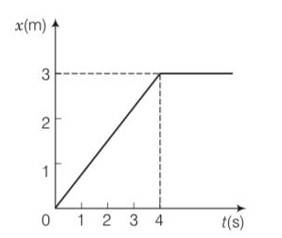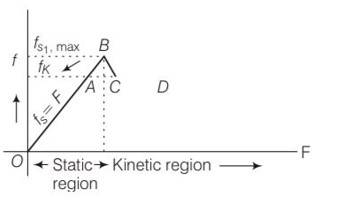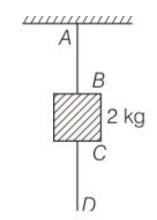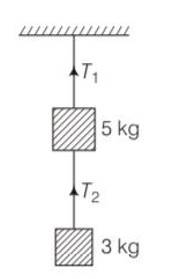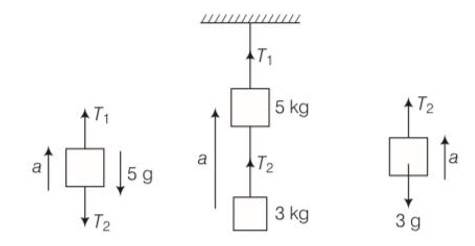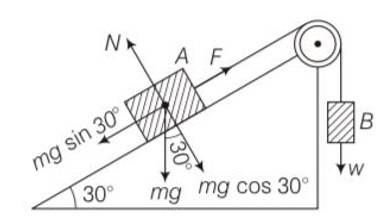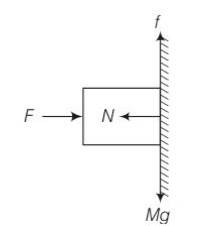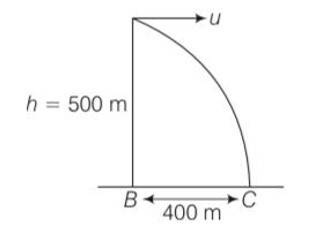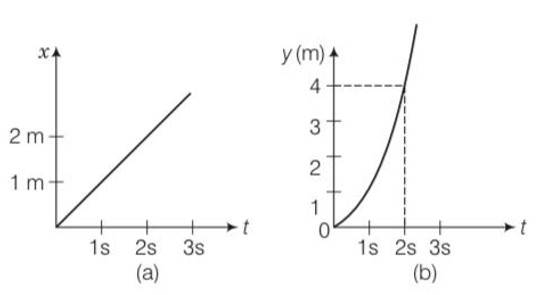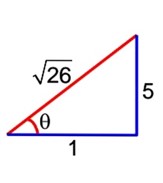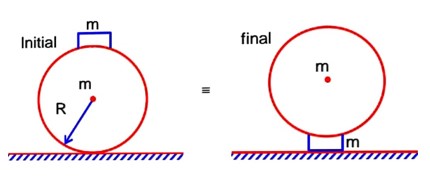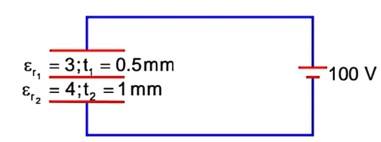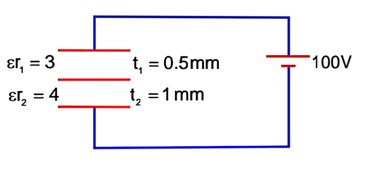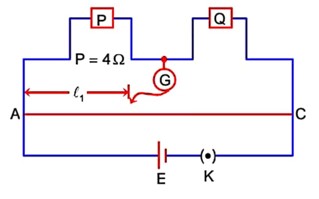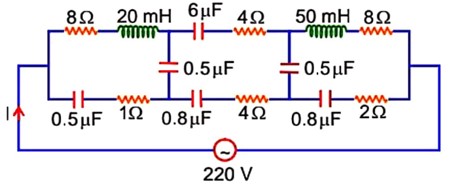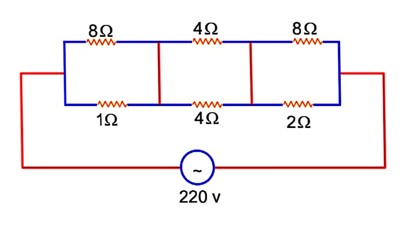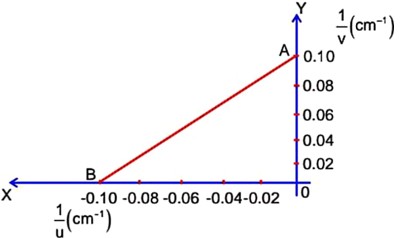
- Laws of Motion Multiple Choice Questions
- Laws of Motion Short Answer type Questions
- Laws of Motion Long Answer Type Questions
- Laws of Motion Short Answer Type Questions
- JEE Mains 2021
Laws of Motion Multiple Choice Questions
| 5.1 A ball is travelling with uniform translatory motion. This means that (a) It is at rest. (b) The path can be a straight line or circular and the ball travels with uniform speed. (c) All parts of the ball have the same velocity (magnitude and direction) and the velocity is constant. (d) The centre of the ball moves with constant velocity and the ball spins about its centre uniformly. |
| Answer- c Explanation- in a uniform translatory motion , all parts of the ball have the same velocity in magnitude and direction and this velocity is constant . in this situation body A will be in translatory motion. |
| 5.2 A metre scale is moving with uniform velocity. This implies (a) The force acting on the scale is zero, but a torque about the centre of mass can act on the scale. (b) The force acting on the scale is zero and the torque acting about centre of mass of the scale is also zero. (c) The total force acting on it need not be zero but the torque on it is zero. (d) Neither the force nor the torque need to be zero. |
| Answer-b Explanation- to solve this question we have to apply newton’s law of motion , in terms of force and change in momentum. as we know F= dp/dt As body moving uniform velocity so dp= 0 So F=0 As all part of scale is moving with uniform velocity and total force is zero . hence torque will also be zero. |
Commonly asked questions
A ball is travelling with uniform translatory motion. This means that
(a) It is at rest.
(b) The path can be a straight line or circular and the ball travels with uniform speed.
(c) All parts of the ball have the same velocity (magnitude and direction) and the velocity is constant.
(d) The centre of the ball moves with constant velocity and the ball spins about its centre uniformly.
This is a Multiple Choice Type Questions as classified in NCERT Exemplar
Answer- c
Explanation- in a uniform translatory motion, all parts of the ball have the same velocity in magnitude and direction and this velocity is constant . in this situation body A will be in translatory motion.
A metre scale is moving with uniform velocity. This implies
(a) The force acting on the scale is zero, but a torque about the centre of mass can act on the scale.
(b) The force acting on the scale is zero and the torque acting about centre of mass of the scale is also zero.
(c) The total force acting on it need not be zero but the torque on it is zero.
(d) Neither the force nor the torque need to be zero.
This is a Multiple Choice type Questions as classified in NCERT Exemplar
Answer-b
Explanation- to solve this question we have to apply newton's law of motion, in terms of force and change in momentum.
as we know F= dp/dt
As body moving uniform velocity so dp= 0
So F=0
As all part of scale is moving with uniform velocity and total force is zero . hence torque will also be zero.
A cricket ball of mass 150 g has an initial velocity u=(3ȋ+4ĵ )m/s and a final velocity v=-(3ȋ+4ĵ) after being hit. The change in momentum (final momentum-initial momentum) is (in kg m s-1)
(a) Zero
(b)-(0.45ȋ+0.6ĵ)
(c) –(0.9j+1.2ĵ)
(d) -5(ȋ+ĵ)ȋ
This is a Multiple Choice type Questions as classified in NCERT Exemplar
Answer- c
Explanation- given u= (3? +4? )m/s
And v= - (3? +4? )m/s, and mass of ball is 150g=0.15kg
Change in momentum = final momentum – initial momentum
= mv-mu
= m (v-u) = 0.15 [- (3? +4? )- (3? +4? )]
= - [0.15 ]
= - [0.9? +1.2? ]
P =- [0.9? +1.2? ]
In the previous problem (5.3), the magnitude of the momentum transferred during the hit is
(a) Zero (b) 0.75 kg m s-1 (c) 1.5 kg m s-1 (d) 14 kg m s-1
This is a Multiple Choice Questions type Questions as classified in NCERT Exemplar
Answer- c
Explanation- change in momentum =- [0.9? +1.2? ]
Magnitude =
1.5 kg m s-1
Conservation of momentum in a collision between particles can be understood from
(a) Conservation of energy.
(b) Newton’s first law only.
(c) Newton’s second law only.
(d) Both Newton’s second and third law.
This is a Multiple Choice Questions type Questions as classified in NCERT Exemplar
Answer- d
Explanation-we know that for a system Fext=dp/dt
If Fext=0, dp =0,
P = constant
Hence, momentum of a system will remain conserve if external force on the system is zero.
In case of collision between particles, equal and opposite forces will act on individual particles by newton's third law.
according to newton's 2nd law F=dp/dt
If F =0 then p = constant so momentum remains constant if external force is zero.
A hockey player is moving northward and suddenly turns westward with the same speed to avoid an opponent. The force that acts on the player is
(a) Frictional force along westward.
(b) Muscle force along southward.
(c) Frictional force along south-west.
(d) Muscle force along south-west.
This is a Multiple Choice Questions type Questions as classified in NCERT Exemplar
Answer- c
Explanation –consider the adjacent diagram
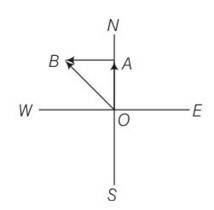
OA= p1= initial momentum of player northward
AB= p2= final momentum of player towards west
OB= OA+AB
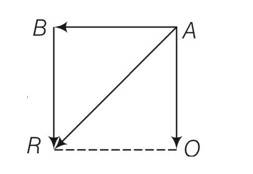
Change in momentum = P2-P1= AB-OA so we can say that AR will be along south west.
A body of mass 2kg travels according to the law x(t)= pt+qt2+rt3 where p=3m/s ,q =4m/s and r= 5m/s . The force acting on the body at t = 2 seconds is
(a) 136 N
(b) 134 N
(c) 158 N
(d) 68 N
This is a Multiple Choice Questions type Questions as classified in NCERT Exemplar
Answer- a
Explanation- x (t)= pt+qt2+rt3
V= dx/dt=p+2qt+3rt2
So a= o+2q+6rt
At t=2s a= 2q+6 2 (r)
= 2q+12r
= 2 (4)+12 (5)=68m/s
So F =ma= 2 (68)= 136N
A body with mass 5 kg is acted upon by a force F= (–3ȋ + 4ĵ)N. If its initial velocity at t = 0 is v=(6ȋ-12ĵ) m/s , the time at which it will just have a velocity along the y-axis is
(a) Never
(b) 10 s
(c) 2 s
(d) 15 s
This is a Multiple Choice Questions type Questions as classified in NCERT Exemplar
Answer- b
Explanation- we know that m= 5 kg
F= (–3? + 4? ) N and
initial velocity v= (6? -12? ) m/s
So retardation a= = ( ) m/s2
We know v=u+at, for X-component only ,0 = 6? -
So t= = 10s
A car of mass m starts from rest and acquires a velocity along east v = vȋ (v>0) in two seconds. Assuming the car moves with uniform acceleration, the force exerted on the car is
(a) mv/2 eastward and is exerted by the car engine.
(b) mv/2 eastward and is due to the friction on the tyres exerted by the road.
(c) more than mv/2 eastward exerted due to the engine and overcomes the friction of the road.
(d) mv/2 exerted by the engine .
This is a Multiple Choice Questions type Questions as classified in NCERT Exemplar
Answer- b
Explanation – mass of car m =0
Initial velocity =0,
velocity at east direction = v?
Time =2s
So v=u+at,
v? =0+a (2)
so a =v/2?
F=ma = so force = mv/2 towards east.
The motion of a particle of mass m is given by x = 0 for t < 0 s, x(t) = A sin4 t for 0 < t<(1/4)s(A>0) and x = 0 for t >(1/4) s. Which of the following statements is true?
(a) The force at t = (1/8) s on the particle is –16π2 A m.
(b) The particle is acted upon by on impulse of magnitude 4π2 A m at t = 0 s and t = (1/4) s.
(c) The particle is not acted upon by any force.
(d) The particle is not acted upon by a constant force.
(e) There is no impulse acting on the particle.
This is a Multiple Choice Questions type Questions as classified in NCERT Exemplar
Answer- a, b, d
Explanation – x=0 for t<0s
X (t)=Asin4 for 0
X=0, for t>1/4s
For,0
Acceleration will be, a= dv/dt=-16 Asin4
At t= 1/8 s, a (t)=-16 Asin4 =-16 A
So force F =ma =-16 Am
Impulse = change in linear momentum = f (t)= -16 Am (1/4)
Impulse = change in linear momentum
=F =-16
= -4 Am so clearly force depends upon a so force is also not constant .
The impulse (change in linear momentum)
At t=0 is same as t=1/4s
Clearly, force depends upon A which is not constant. Hence, force is also not constant.
In Fig., the co-efficient of friction between the floor and the body B is 0.1. The co-efficient of friction between the bodies B and A is 0.2. A force F is applied as shownon B. The mass of A is m/2 and of B is m. Which of the following statements are true?
(a) The bodies will move together if F = 0.25 mg.
(b) The body A will slip with respect to B if F = 0.5 mg.
(c) The bodies will move together if F = 0.5 mg.
(d) The bodies will be at rest if F = 0.1 mg.
(e) The maximum value of F for which the two bodies will move together is 0.45 mg.
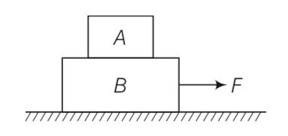
This is a Multiple Choice Questions type Questions as classified in NCERT Exemplar
Answer- a, b, d, e
Explanation- suppose A and B are moving together acommon=
Pseudo force = mA (acommon)= =
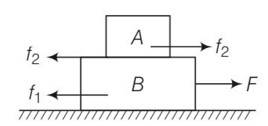
Force will be maximum when pseudo force and frictional force are equal to one another
=
= 0.2
Fmax= 0.3mg+f1
= 0.3mg+0.1 (3/2)mg= 0.45mg
(a) for F=0.25mg
(b) for F=0.5mg>Fmax body A will slip with respect to B
(c) for F=0.5mg>Fmax bodies will slip
Mass m1 moves on a slope making an angle θ with the horizontal and is attached to mass m2 by a string passing over a frictionless pulley as shown in Fig. The co-efficient of friction between m1 and the sloping surface is µ. Which of the following statements are true?
(a) If m2 > m1 sin θ , the body will move up the plane.
(b) If m2 > m1 (sin θ + µcos θ) , the body will move up the plane.
(c) If m2 < m1 (sin θ + µcos θ) , the body will move up the plane.
(d) If m2 < m1 (sin θ - µcos θ) , the body will move down the plane..
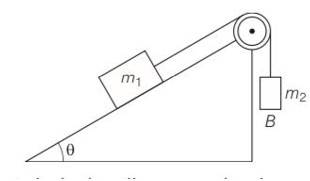
This is a Multiple Choice Questions type Questions as classified in NCERT Exemplar
Answer- b, d
Explanation – as we know f =
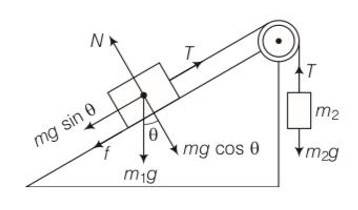
For system m1+m2 to move up
So m2g- (m1gsin )>0
So m2g- (m1gsin )>0
So m2>m1 (sin )
But if bodies moves downward
m1gsin 2g
m1gsin> m2g
m2
In Fig , a body A of mass m slides on plane inclined at angle θ1 to the horizontal and µ1 is the coefficient of friction between A and the plane. A is connected by a light string passing over a frictionless pulley to another body B, also of mass m, sliding on a frictionless plane inclined at angle θ2 to the horizontal. Which of the following statements are true?
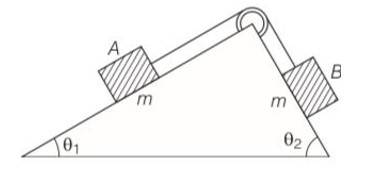
(a) A will never move up the plane.
(b) A will just start moving up the plane when µ= .
(c) For A to move up the plane, θ2 must always be greater than θ1 .
(d) B will always slide down with constant speed.
This is a Multiple Choice Questions type Questions as classified in NCERT Exemplar
Answer- b, c
Explanation- when A starts moving up
Mgsin
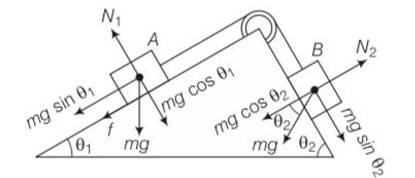
mgsin + =
When A moves downward f= mgsin so clearly
Two billiard balls A and B, each of mass 50g and moving in opposite directions with speed of 5m s-1 each, collide and rebound with the same speed. If the collision lasts for 10-3 s, which of the following statements are true?
(a) The impulse imparted to each ball is 0.25 kg m s-1 and the force on each ball is 250 N.
(b) The impulse imparted to each ball is 0.25 kg m s–1 and the force exerted on each ball is 25 × 10-5 N.
(c) The impulse imparted to each ball is 0.5 Ns.
(d) The impulse and the force on each ball are equal in magnitude and opposite in direction.
This is a Multiple Choice Questions type Questions as classified in NCERT Exemplar
Answer- c, d
Explanation – m1=m2 = 50g= 1/20kg
Initial velocity u1=u2= 5m/s
Final velocity v1=v2= -5m/s
Time duration = 10-3s
Change in linear 1momentum = m (v-u)= 1/20 (-5-5)=-0.5N-s
Force = impulse /time=0.5/10-3= 500N
So impulse and force are opposite in directions.
A body of mass 10kg is acted upon by two perpendicular forces, 6N and 8N. The resultant acceleration of the body is
(a) 1 m s-2 at an angle of tan-1(3/4) w.r.t. 6N force.
(b) 0.2 m s-2 at an angle of tan-1(3/4) w.r.t. 6N force.
(c) 1 m s-2 at an angle of tan-1(3/4) w.r.t.8N force.
(d) 0.2 m s-2 at an angle of tan-1(3/4) w.r.t.8N force.
This is a Multiple Choice Questions type Questions as classified in NCERT Exemplar
Answer- a, c
Explanation – mass m= 10kg
F1 =6N, F2= 8N
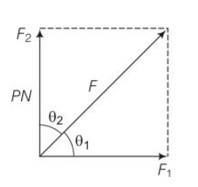
Resultant force F=
a=f/m= 10/10= 1m/s2
let 1 be the angle between R and F1
tan 1=8/6=4/3
1= tan 1 (4/3) w.r.t F1=6N
let 2 be the angle between F and F2
tan 1=8/6=4/3
2= tan 2 (4/3) w.r.t F2=8N
An npn transistor operates as a common emitter amplifier with a power gain of 10?. The input circuit resistance is 100Ω and the output load resistance is 10kΩ. The common emitter current gain 'β' will be -----------. (Round off to the Nearest Integer)
Power gain = (i_c² R_c) / (i_b² R_B) = (i_c/i_b)² (R_c/R_B) = (10²)² (10? /10³) = 10?
i_c/i_b = 100 ⇒ β = i_c/i_b = 100
A parallel plate capacitor has plate area 100m² and plate separation of 10m. The space between the plates is filled up to a thickness 5m with material of dielectric constant of 10. The resultant capacitance of the system is 'x' pF.
The value of ε? = 8.85 × 10?¹² F.m?¹
The value of 'x' to the nearest integer is ----------.
1/C = 5/ (ε? × 100) + 5/ (10ε? × 100)
⇒ C = (ε? × 1000) / 55 = (8.85 × 10? ¹² × 1000) / 55 = 1.61 × 10? ¹? F = 161 pF
The voltage across the 10Ω resistor in the given circuit is x volt. The value of 'x' to the nearest integer is ----------.
R_eq = 10 + (50 × 20) / (50 + 20) = 170/7 Ω
⇒ I = 170 / (170/7) = 7A
⇒ x = 10 × 7 = 70V ⇒ Voltage across 10Ω resistor
A bullet of mass 0.1 kg is fired on a wooden block to pierce through it, but it stops after moving a distance of 50 cm into it. If the velocity of bullet before hitting the wood is 10m/s and slows down with uniform deceleration, then magnitude effective retarding force on the bullet is 'x' N. The value of 'x' to the nearest integer is----------.
Deceleration, a = u² / 2S = 10² / (2 × 0.5) = 100 m/s².
Retarding force, F = MA = 0.1 × 100 = 10N
A ball of mass 10kg, moving with a velocity 10√3 m/s along, the x-axis, hits another ball of mass 20kg which is at rest. After the collision, first ball comes to rest while second ball disintegrates into two equal pieces. One piece starts moving along y-axis with a speed of 10 m/s. The second piece starts moving at an angle of 30° with respect to the x-axis. The velocity of the ball moving at 30° with x-axis is x m/s. The configuration of pieces after collision is shown in the figure below. The value of x to the nearest integer is---------
Apply conservation of momentum along y-axis, we can write
10v? - 10v? sin 30° = 0
⇒ v? = 20m/s
A person is swimming with a speed of 10m/s at an angle of 120° with the flow and reaches to a point directly opposite on the other side of the river. The speed of the flow is 'x' m/s. The value of 'x' to the nearest integer is-----------.
Angle from direction of flow = 90° + θ = 120°
⇒ θ = 30°
sin 30° = u/v ⇒ u/10 = 1/2 ⇒ u = 5 m/s
Two separate wires A and B are stretched by 2 mm and 4 mm respectively, when they are subjected to a force of 2 N. Assume that both the wires are made up of same material and the radius of wire B is 4 times that of the radius of wire A. The length of the wires A and B are in the ratio of a : b. Then a/b can be expressed as 1/x where x is---------.
For Wire-A
F / (πr_A²) = Y (l_A / 2) . (1)
For Wire-B
F / (πr_B²) = Y (l_B / 4) . (2)
From equations (1) and (2), we can write
(l_A / (2r_A²) = (l_B / (4r_B²) ⇒ l_B/l_A = 2 (r_B/r_A)² ⇒ x = l_B = 32
The circuit shown in the figure consists of a charged capacitor of capacity 3μF and a charge of 30μC. At time t = 0, when the key is closed, the value of current flowing through the 5MΩ resistor is 'x' μA. The value of 'x' to the nearest integer is---------.
Potential difference across resistor at time t = V = 30/3 = 10V
Current, I = 10 / (5 * 10? ) = 2? A
As shown in the figure, a particle of mass 10 kg is placed at a point A. When the particle is slightly displaced to its right, it starts moving and reaches the point B. The speed of the particle at B is x m/s. (Take g = 10 m/s²) The value of 'x' to the nearest integer is----------.
Using Conservation of Mechanical Energy at point-A and at point-B, we can write
K_B = U_A - U_B [Since K_A = 0]
⇒ (1/2)mv_B² = mg (h_A - h_B)
⇒ v_B = √ (2 × 10 × (10 - 5) = 10m/s
A particle performs simple harmonic motion with a period of 2 second. The time taken by the particle to cover a displacement equal to half of its amplitude from the mean position is 1/a s. The value of 'a' to the nearest integer is-----------.
While the particle moves from mean position to displacement, half of its amplitude, its phase changes by π/6 rad. So,
Time taken, t = (π/6)/ω = T/12 = (2/12)s = (1/6)s
a = 6
Laws of Motion Short Answer type Questions
| 1. A girl riding a bicycle along a straight road with a speed of 5 m s-1 throws a stone of mass 0.5 kg which has a speed of 15 m s-1 with respect to the ground along her direction of motion. The mass of the girl and bicycle is 50 kg. Does the speed of the bicycle change after the stone is thrown? What is the change in speed, if so? |
| explanation-total mass of bicycle and stone =m1=50+0.5= 50.5kg Velocity of bicycle u1= 5m/s mass of stone m2= 0.5kg Velocity of stone u2= 15m/s mass of girl and bicycle m= 50kg Also the speed of bicycle change when stone is thrown According to conservation of linear momentum m1u1=m2u2+mv 50.5(5)= 0.5(15)+50(v) V= 4.9m/s Change in speed 5-4.9= 0.1m/s |
| 2. A person of mass 50 kg stands on a weighing scale on a lift. If the lift is descending with a downward acceleration of 9 m s-2, what would be the reading of the weighing scale? (g = 10 m s-2 ) |
| Explanation – w’=R=m(g-a) Mass of person =50kg Descending acceleration= 9m/s2 Acceleration due to gravity g= 10m/s2 Apparent weight of person R= m(g-a) = 50(10-9)=50N Reading in weighing scale = 50/10 =5kg |
Commonly asked questions
A girl riding a bicycle along a straight road with a speed of 5 m s-1 throws a stone of mass 0.5 kg which has a speed of 15 m s-1 with respect to the ground along her direction of motion. The mass of the girl and bicycle is 50 kg. Does the speed of the bicycle change after the stone is thrown? What is the change in speed, if so?
This is a Short Answer type Questions as classified in NCERT Exemplar
explanation-total mass of bicycle and stone =m1=50+0.5= 50.5kg
Velocity of bicycle u1= 5m/s mass of stone m2= 0.5kg
Velocity of stone u2= 15m/s mass of girl and bicycle m= 50kg
Also the speed of bicycle change when stone is thrown
According to conservation of linear momentum
m1u1=m2u2+mv
50.5 (5)= 0.5 (15)+50 (v)
V= 4.9m/s
Change in speed 5-4.9= 0.1m/s
A person of mass 50 kg stands on a weighing scale on a lift. If the lift is descending with a downward acceleration of 9 m s-2, what would be the reading of the weighing scale? (g = 10 m s-2 )
This is a Short Answer type Questions as classified in NCERT Exemplar
Explanation – w'=R=m (g-a)
Mass of person =50kg
Descending acceleration= 9m/s2
Acceleration due to gravity g= 10m/s2
Apparent weight of person R= m (g-a)
= 50 (10-9)=50N
Reading in weighing scale = 50/10 =5kg
The position time graph of a body of mass 2 kg is as given in Fig. 5.4. What is the impulse on the body at t = 0 s and t = 4 s
This is a Short Answer type Questions as classified in NCERT Exemplar
Explanation- mass of body =2kg
From the above graph the body at x=0 when t=0 so body at rest.
So impulse is also zero.
From t=0s to t=4s graph becomes straight line which shows body is at uniform velocity
Beyond 4s graph is parallel to time axis, body is at rest
So tan =3/4
Impulse at t=4s= change in momentum= mv-mu
=m (v-u)
= 2 (0-3/4)= -3/2kgm/s
A person driving a car suddenly applies the brakes on seeing a child on the road ahead. If he is not wearing seat belt, he falls forward and hits his head against the steering wheel. Why?
This is a Short Answer type Questions as classified in NCERT Exemplar
Explanation- when a person driving car suddenly applies brakes the lower comes to rest but the upper part of the body will remain in motion. so if the driver not wearing seat belt will falls forward and his head hit against the steering wheel.
The velocity of a body of mass 2 kg as a function of t is given by 2tȋ+t2ĵ. Find the momentum and the force acting on it, at time t= 2s.
This is a Short Answer type Questions as classified in NCERT Exemplar
Explantion - given mass of the body = 2kg
Velocity of the body = 2t? +t2?
Velocity of body at t=2s
V= 2 ? +22? = 4? +4?
Momentum of body =mv = 2 (4? +4? )= 8? +8? kgm/s
Acceleration a= dv/dt
= d/dt (2t? +t2? )= 2? +2t?
At t=2s, a= (2i+2 (2)j)= 2? +4?
Force acting on the body F=ma
=2 (2? +4? )
= 4? +8? N
A block placed on a rough horizontal surface is pulled by a horizontal force F. Let f be the force applied by the rough surface on the block. Plot a graph of f versus F.
This is a Short Answer type Questions as classified in NCERT Exemplar
Explanation -the frictional force shown on vertical axis and the applied force shown on horizontal axis. The portion OA of graph represents static friction which is a self-adjusting .in this f=F.
Whereas the point B represents force of limiting friction . Cd|OX represents kinetic friction. The force of kinetic friction does not change by applying force.
Why are porcelain objects wrapped in paper or straw before packing for transportation?
This is a Short Answer type Questions as classified in NCERT Exemplar
Explanation- porcelain objects are wrapped in paper while transporting because they are very fragile can easily break. while we wrapped them in paper to increase the time so the damage to them is as less as possible.
Why does a child feel more pain when she falls down on a hard cement floor, than when she falls on the soft muddy ground in the garden?
This is a Short Answer type Questions as classified in NCERT Exemplar
Explanation-when she falls on cemented floor the time is very less so force is very large which increase the pain but F =change in momentum =constant . while in muddy ground the time is very large as compared to cemented floor so less will be applied . so she feel less pain.
A woman throws an object of mass 500 g with a speed of 25 m s1.
(a) What is the impulse imparted to the object?
(b) If the object hits a wall and rebounds with half the original speed, what is the change in momentum of the object?
This is a Short Answer type Questions as classified in NCERT Exemplar
Explanation- mass of the objects =0.5kg
Speed of the objects =25m/s
a) impulse imparted = change in momentum = mv-mu
= m (v-u)= 0.5 (25-0)=12.5N-s
b) velocity of the object after rebounding= 25/2=-12.5m/s
change in momentum = m (v-u)= 0.5 (-12.5-25)= -18.75N-s
Why are mountain roads generally made winding upwards rather than going straight up?
This is a Short Answer type Questions as classified in NCERT Exemplar
Explanation- while going up a mountain the force of friction acting on a vehicle of mass m is f=
= To avoid skidding force of friction should be large and therefore cos should be large and should be small. That is why mountain roads generally made winding upwards rather than going straight up.
A mass of 2kg is suspended with thread AB (Fig. 5.5). Thread CD of the same type is attached to the other end of 2 kg mass. Lower thread is pulled gradually, harder and harder in the downward direction so as to apply force on AB. Which of the threads will break and why?
This is a Short Answer type Questions as classified in NCERT Exemplar
Explanation- The thread AB will break earlier than the thread CD. This is because force acting on thread CD= applied force and force acting on thread AB = applied force +weight of 2kg mass. Hence force acting on thread Ab is larger than the force acting on thread CD
In the above given problem if the lower thread is pulled with a jerk, what happens?
This is a Short Answer type Questions as classified in NCERT Exemplar
Explanation – when the lower thread CD is pulled with a * the thread Cd itself break because the thread CD is not transmitted to the thread Ab instantly.
Two masses of 5 kg and 3 kg are suspended with help of massless inextensible strings as shown in Fig. 5.6. Calculate T1 and T2 when whole system is going upwards with acceleration = 2 m/s2 (use g = 9.8 m/s2).
This is a Short Answer type Questions as classified in NCERT Exemplar
Explanation- m1= 5kg, m2= 3kg
And g= 9.8m/s2 and a= 2m/s2
For the upper block T1-T2-5g=5a
T1-T2= 5 (g+a)
For the lower block T2-3g =3a
T2=3 (g+a)=3 (9.8+2)=35.4N
T1=T2+5 (g+a)=94.4N
Block A of weight 100 N rests on a frictionless inclined plane of slope angle 30° (Fig. 5.7). A flexible cord attached to A passes over a frictionless pulley and is connected to block B of weight W. Find the weight W for which the system is in equilibrium.
This is a Short Answer type Questions as classified in NCERT Exemplar
Explanation- in equilibrium, The force mgsin acting on the block A is parallel to the plane should be balanced by the tension in the string
mgsin
and for block B, w=T=F
from these two above equation
w=mgsin = 100sin30= 100 (1/2)=50N
A block of mass M is held against a rough vertical wall by pressing it with a finger. If the coefficient of friction between the block and the wall is µ and the acceleration due to gravity is g, calculate the minimum force required to be applied by the finger to hold the block against the wall ?
This is a Short Answer type Questions as classified in NCERT Exemplar
Explanation-given mass of the block =M
Coefficient of friction between block and the wall =
In equilibrium condition vertical and horizontal component balance each other
So f=mg
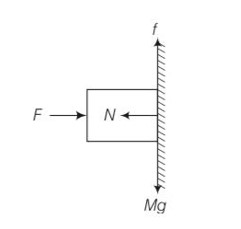
And F=N but the force of friction f=
F= Mg/ ![]()
A 100 kg gun fires a ball of 1kg horizontally from a cliff of height 500m. It falls on the ground at a distance of 400m from the bottom of the cliff. Find the recoil velocity of the gun. (acceleration due to gravity = 10 m/s-2)
This is a Short Answer type Questions as classified in NCERT Exemplar
Explanation- mass of gun =100kg
Mass of ball =1kg and height of cliff = 500m
So horizontal distance travelled by the ball is x = 400m
So h =1/2gt2
500= 2 so t= 10s
X=ut then u= 400/10=40m/s
According to principle of conservation pf momentum
Mv=mu
V= 40/100= 0.4m/s
Figure 5.8 shows (x, t), (y, t ) diagram of a particle moving in 2-dimensions If the particle has a mass of 500 g, find the force (direction and magnitude) acting on the particle.
Explanation- from the diagram x= t=dx/dt=1m/s
So ax= 0
From the diagram y =t2
dy/dt=2t or ay=d2y/dt2=2m/s2
Iy= may=500 (10-3) (2) =1N
Fx=max=0
F= = 1N
A person in an elevator accelerating upwards with an acceleration of 2 m s–2, tosses a coin vertically upwards with a speed of 20 m s-1. After how much time will the coin fall back into his hand? ( g = 10 m s–2)
This is a Short Answer type Questions as classified in NCERT Exemplar
Explanation -initial speed of coin u= 20m/s
Acceleration of elevator =2m/s2 acceleration due to gravity = 10m/s2
Effective acceleration =g+a=12m/s2
We know that v=u +at
0= 20+ (-12)t
So t= 20/12=5/3 s
Time of ascent = time of descent
Total time coin fall back into hand = (5/3+5/3)=10/3s=3.33s
Laws of Motion Long Answer Type Questions
| 5.1 There are three forces F1, F2 and F3 acting on a body, all acting on a point P on the body. The body is found to move with uniform speed. (a) Show that the forces are coplanar. (b) Show that the torque acting on the body about any point due to these three forces is zero. |
| Explanation – as body moving with uniform acceleration a=0 The sum of forces is zero F1+F2+F3=0 a)let F1,F2,F3 be the three forces passing through the point . let F1and F2 be in the plane A so F3 =-(F1+F2) so F3 is also in plane A. b)consider the torque of the forces about P . since all the forces pass through P the torque is zero torque = OP(F1+F2+F3) since F1+F2+F3=0 so torque =0 |
| 5.2 When a body slides down from rest along a smooth inclined plane making an angle of 45° with the horizontal, it takes time T. When the same body slides down from rest along a rough inclined plane making the same angle and through the same distance, it is seen to take time pT, where p is some number greater than 1. Calculate the co-efficient of friction between the body and the rough plane. |
| Explanation- as angle is 45 On smooth inclined plane acceleration will be a = gsin So acceleration will become a= g/ Using equation of motion s =ut +1/2at2 S= On rough inclined plane a = g(sin ) = g(sin )= So s=ut +1/2at2 S= 0+ 2 Comparing two above distance 2= So after solving we get |
Commonly asked questions
There are three forces F1, F2 and F3 acting on a body, all acting on a point P on the body. The body is found to move with uniform speed.
(a) Show that the forces are coplanar.
(b) Show that the torque acting on the body about any point due to these three forces is zero.
This is a Long Answer type Questions as classified in NCERT Exemplar
Explanation – as body moving with uniform acceleration a=0
The sum of forces is zero F1+F2+F3=0
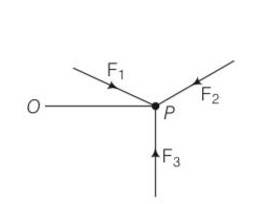
a)let F1, F2, F3 be the three forces passing through the point . let F1and F2 be in the plane A
so F3 =- (F1+F2) so F3 is also in plane A.
b)consider the torque of the forces about P . since all the forces pass through P the torque is zero
torque = OP (F1+F2+F3)
since F1+F2+F3=0 so torque =0
When a body slides down from rest along a smooth inclined plane making an angle of 45° with the horizontal, it takes time T. When the same body slides down from rest along a rough inclined plane making the same angle and through the same distance, it is seen to take time pT, where p is some number greater than 1. Calculate the co-efficient of friction between the body and the rough plane.
This is a Long Answer type Questions as classified in NCERT Exemplar
Explanation- as angle is 45
On smooth inclined plane acceleration will be a = gsin
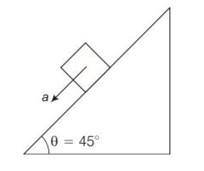
So acceleration will become a= g/
Using equation of motion s =ut +1/2at2
S=
On rough inclined plane a = g (sin )
= g (sin )=
So s=ut +1/2at2
S= 0+ 2
Comparing two above distance
2=
So after solving we get
Figure shows (vx ,t) and (vy,t) diagrams for a body of unit mass. Find the force as a function of time.
This is a Long Answer type Questions as classified in NCERT Exemplar
Explanation- vx=2t for 0
= 2 (2-t) for 1
=0 for t>2s
Vy= t for 0
= 1 for t>1s
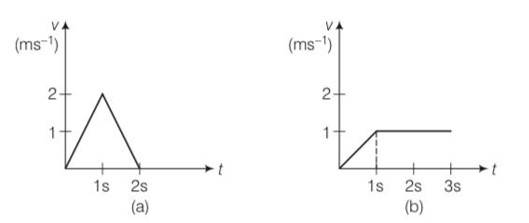
Fx= max= mdvx/dt= 1 (2)
Fy = may= mdvy/dt
= 1 (1) for 0
F= Fx? +Fy?
= 2? +?
=-2?
=0
A racing car travels on a track (without banking) ABCDEFA (Fig). ABC is a circular arc of radius 2 R. CD and FA are straight paths of length R and DEF is a circular arc of radius R = 100 m. The coefficient of friction on the road is µ = 0.1. The maximum speed of the car is 50 m s–1. Find the minimum time for completing one round.
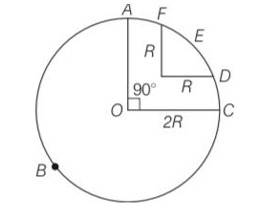
This is a Long Answer type Questions as classified in NCERT Exemplar
Explanation – centripetal force, F= mv2/r= f=
V=
For path ABC path length =3/4 (2 )=
V1=
So t= 300
For path DEF path length =
V2=
So t2= 50 = 15.7s
For path CD and FA
Path length =R+R= 200m
T= 200/50= 4s
Total time = 66.6+15.7+4= 86.3s
The displacement vector of a particle of mass m is given by r(t)=ȋ A cos ĵ B sinwt.
(a) Show that the trajectory is an ellipse.
(b) Show that F= -mw2/r
This is a Long Answer type Questions as classified in NCERT Exemplar
Explanation- displacement vector of particle is r (t)=? Acos ? Bsinwt
X=Acoswt
x/A= coswt………1
displacement along y axis is
y=Bsinwt
y/B= sinwt……….2
squaring and then adding eqn1 and 2 we get
x2/A2+y2/B2=cos2wt+sin2wt =1
this is an equation of ellipse. Therefore trajectory of particle is an ellipse.
b)v= dr/dt= id/dt (Acoswt)+jd/dt (Bsinwt)
? [A (-sinwt)w]+? [B (coswt).w]
= -? Awsinwt+? Bwcoswt
Acceleration a= dv/dt
So a= -? Awd/dt (sinwt)+? Bw [-sinwt]w
=? Aw2coswt-? Bsinwt
= -w2r
So force acting on the particle f=ma=-mrw2
A cricket bowler releases the ball in two different ways
(a) Giving it only horizontal velocity, and
(b) Giving it horizontal velocity and a small downward velocity.
The speed vs at the time of release is the same. Both are released at a height H from the ground. Which one will have greater speed when the ball hits the ground? Neglect air resistance.
This is a Long Answer type Questions as classified in NCERT Exemplar
Explanation – horizontal velocity ux= vs
During projectile motion horizontal velocity remains unchanged
Vx=ux=vs
In vertical direction vy2= uy2+2gH
There are four forces acting at a point P produced by strings as shown in Fig. , which is at rest. Find the forces F1 and F2
This is a Long Answer type Questions as classified in NCERT Exemplar
Explanation- on resolving forces into rectangular components in equilibrium forces (F1+1/ )N are equal to and F2 is equal to ( )N
F1+1/ =
F1= =
F2=
A rectangular box lies on a rough inclined surface. The co-efficient of friction between the surface and the box is µ. Let the mass of the box be m.
(a) At what angle of inclination θ of the plane to the horizontal will the box just start to slide down the plane?
(b) What is the force acting on the box down the plane, if the angle of inclination of the plane is increased to α θ > ?
(c) What is the force needed to be applied upwards along the plane to make the box either remain stationary or just move up with uniform speed?
(d) What is the force needed to be applied upwards along the plane to make the box move up the plane with acceleration a?
This is a Long Answer type Questions as classified in NCERT Exemplar
Explanation -for the box to just starts sliding down mg
sin
A helicopter of mass 2000 kg rises with a vertical acceleration of 15 m s–2. The total mass of the crew and passengers is 500 kg. Give the magnitude and direction of the (g = 10 m s–2)
(a) Force on the floor of the helicopter by the crew and passengers.
(b) Action of the rotor of the helicopter on the surrounding air.
(c) Force on the helicopter due to the surrounding air.
This is a Long Answer type Questions as classified in NCERT Exemplar
Explanation- mass of helicopter m =2000kg
Mass of the crew and passengers m= 500kg
Acceleration a =15m/s2 and g = 10m/s2
a) force on the floor of the helicopter by the crew and passengers
m (g+a)= 500 (10+15)N= 12500N
b) action of rotor of the helicopter on the surroundings air= (m1+m2) (g+a)
= (2000+500) (10+15)= 2500 (25)= 62500N
c) force on the helicopter due to surroundings air
= reaction of force applied by helicopter
= 62500N
Laws of Motion Short Answer Type Questions
| 5.1 A girl riding a bicycle along a straight road with a speed of 5 m s-1 throws a stone of mass 0.5 kg which has a speed of 15 m s-1 with respect to the ground along her direction of motion. The mass of the girl and bicycle is 50 kg. Does the speed of the bicycle change after the stone is thrown? What is the change in speed, if so? |
| Explanation-total mass of bicycle and stone =m1=50+0.5= 50.5kg Velocity of bicycle u1= 5m/s mass of stone m2= 0.5kg Velocity of stone u2= 15m/s mass of girl and bicycle m= 50kg Also the speed of bicycle change when stone is thrown According to conservation of linear momentum m1u1=m2u2+mv 50.5(5)= 0.5(15)+50(v) V= 4.9m/s Change in speed 5-4.9= 0.1m/s |
| 5.2 A person of mass 50 kg stands on a weighing scale on a lift. If the lift is descending with a downward acceleration of 9 m s-2, what would be the reading of the weighing scale? (g = 10 m s-2 ) |
| Explanation – w’=R=m(g-a) Mass of person =50kg Descending acceleration= 9m/s2 Acceleration due to gravity g= 10m/s2 Apparent weight of person R= m(g-a) = 50(10-9)=50N Reading in weighing scale = 50/10 =5kg |
| 5.3 The position time graph of a body of mass 2 kg is as given in Fig. 5.4. What is the impulse on the body at t = 0 s and t = 4 s |
| Explanation- mass of body =2kg From the above graph the body at x=0 when t=0 so body at rest. So impulse is also zero. From t=0s to t=4s graph becomes straight line which shows body is at uniform velocity Beyond 4s graph is parallel to time axis , body is at rest So tan =3/4 Impulse at t=4s= change in momentum= mv-mu =m(v-u) = 2(0-3/4)= -3/2kgm/s |
| 5.4 A person driving a car suddenly applies the brakes on seeing a child on the road ahead. If he is not wearing seat belt, he falls forward and hits his head against the steering wheel. Why? |
| Explanation- when a person driving car suddenly applies brakes the lower comes to rest but the upper part of the body will remain in motion. so if the driver not wearing seat belt will falls forward and his head hit against the steering wheel. |
| 5.5 The velocity of a body of mass 2 kg as a function of t is given by 2tȋ+t2ĵ. Find the momentum and the force acting on it, at time t= 2s. |
| Explantion - given mass of the body = 2kg Velocity of the body = 2tȋ+t2ĵ Velocity of body at t=2s V= 2 ȋ+22ĵ= 4ȋ+4ĵ Momentum of body =mv = 2(4ȋ+4ĵ)= 8ȋ+8ĵ kgm/s Acceleration a= dv/dt = d/dt(2tȋ+t2ĵ)= 2ȋ+2tĵ At t=2s , a= (2i+2(2)j)= 2ȋ+4ĵ Force acting on the body F=ma =2(2ȋ+4ĵ) = 4ȋ+8ĵ N |
| 5.6 A block placed on a rough horizontal surface is pulled by a horizontal force F. Let f be the force applied by the rough surface on the block. Plot a graph of f versus F. |
| Explanation -the frictional force shown on vertical axis and the applied force shown on horizontal axis. The portion OA of graph represents static friction which is a self-adjusting .in this f=F. Whereas the point B represents force of limiting friction . Cd||OX represents kinetic friction. The force of kinetic friction does not change by applying force. |
| 5.7 Why are porcelain objects wrapped in paper or straw before packing for transportation? |
| Explanation- porcelain objects are wrapped in paper while transporting because they are very fragile can easily break. while we wrapped them in paper to increase the time so the damage to them is as less as possible. |
| 5.8 Why does a child feel more pain when she falls down on a hard cement floor, than when she falls on the soft muddy ground in the garden? |
| Explanation-when she falls on cemented floor the time is very less so force is very large which increase the pain but F= change in momentum =constant . while in muddy ground the time is very large as compared to cemented floor so less will be applied . so she feel less pain. |
| 5.9 A woman throws an object of mass 500 g with a speed of 25 m s1. (a) What is the impulse imparted to the object? (b) If the object hits a wall and rebounds with half the original speed, what is the change in momentum of the object? |
| Explanation- mass of the objects =0.5kg Speed of the objects =25m/s a) impulse imparted = change in momentum = mv-mu = m(v-u)= 0.5(25-0)=12.5N-s b) velocity of the object after rebounding= 25/2=-12.5m/s change in momentum = m(v-u)= 0.5(-12.5-25)= -18.75N-s |
| 5.11 A mass of 2kg is suspended with thread AB (Fig. 5.5). Thread CD of the same type is attached to the other end of 2 kg mass. Lower thread is pulled gradually, harder and harder in the downward direction so as to apply force on AB. Which of the threads will break and why? |
| Explanation- The thread AB will break earlier than the thread CD. This is because force acting on thread CD= applied force and force acting on thread AB = applied force +weight of 2kg mass. Hence force acting on thread Ab is larger than the force acting on thread CD |
| 5.12 In the above given problem if the lower thread is pulled with a jerk, what happens? |
| Explanation – when the lower thread CD is pulled with a jerk the thread Cd itself break because the thread CD is not transmitted to the thread Ab instantly. |
| 5.13 Two masses of 5 kg and 3 kg are suspended with help of massless inextensible strings as shown in Fig. 5.6. Calculate T1 and T2 when whole system is going upwards with acceleration = 2 m/s2 (use g = 9.8 m/s2). |
| Explanation- m1= 5kg , m2= 3kg And g= 9.8m/s2 and a= 2m/s2 For the upper block T1-T2-5g=5a T1-T2= 5(g+a) For the lower block T2-3g =3a T2=3(g+a)=3(9.8+2)=35.4N T1=T2+5(g+a)=94.4N |
| 5.14 Block A of weight 100 N rests on a frictionless inclined plane of slope angle 30° (Fig. 5.7). A flexible cord attached to A passes over a frictionless pulley and is connected to block B of weight W. Find the weight W for which the system is in equilibrium. |
| Explanation- in equilibrium, The force mgsin acting on the block A is parallel to the plane should be balanced by the tension in the string mgsin and for block B , w=T=F from these two above equation w=mgsin = 100sin30= 100(1/2)=50N |
| 5.15 A block of mass M is held against a rough vertical wall by pressing it with a finger. If the coefficient of friction between the block and the wall is µ and the acceleration due to gravity is g, calculate the minimum force required to be applied by the finger to hold the block against the wall ? |
| Explanation-given mass of the block =M Coefficient of friction between block and the wall = In equilibrium condition vertical and horizontal component balance each other So f=mg And F=N but the force of friction f=
F= Mg/ |
| 5.16 A 100 kg gun fires a ball of 1kg horizontally from a cliff of height 500m. It falls on the ground at a distance of 400m from the bottom of the cliff. Find the recoil velocity of the gun. (acceleration due to gravity = 10 m/s-2) |
| Explanation- mass of gun =100kg Mass of ball =1kg and height of cliff = 500m So horizontal distance travelled by the ball is x = 400m So h =1/2gt2 500= 2 so t= 10s X=ut then u= 400/10=40m/s According to principle of conservation pf momentum Mv=mu V= 40/100= 0.4m/s |
| 5.18 A person in an elevator accelerating upwards with an acceleration of 2 m s–2, tosses a coin vertically upwards with a speed of 20 m s-1. After how much time will the coin fall back into his hand? ( g = 10 m s–2) |
| Explanation -initial speed of coin u= 20m/s Acceleration of elevator =2m/s2 acceleration due to gravity = 10m/s2 Effective acceleration =g+a=12m/s2 We know that v=u +at 0= 20+(-12)t So t= 20/12=5/3 s Time of ascent = time of descent Total time coin fall back into hand = (5/3+5/3)=10/3s=3.33s |
Commonly asked questions
If the initial velocity in horizontal direction of a projectile is unit vector and the equation of trajectory is y = 5x(1 – x). The y component vector of the initial velocity is ________ .
y = x5 (1 – x) = x tan θ
tan = 5, R = 1
y – component of initial velocity
= u sin θ
=
= 5 m/s
A disc of mass 1kg and radius R is free to rotate about a horizontal axis passing through its centre and perpendicular to the plane of disc. A body of same mass as that of disc is fixed at the highest point of the disc. Now the system is released, when the body comes to the lowest position, its angular speed will be where x = __________.
Loss in P.E. = Gain in k.E
2 mg R =
In an experiment to determine the Young’s modulus of wire of a length exactly 1m, the extension in the length of the wire is measured as 0.4mm with an uncertainty of 0.02mm when a load of 1kg is applied. The diameter of the wire is measured as 0.4mm with an uncertainty of 0.02mm. The error in the measurement of Young’s modulus is found to be x × 1010Nm-2. The value of x is _________.
(take g = 10 ms-2)
L = 1 m
d = 0.4 × 103 m
= 1.99
When a car is approaching the observer, the frequency of horn is 100Hz. After passing the observer, it is 50 Hz. If the observer moves with the car, the frequency will be Ha where x = _________.
C = Speed of sound
Vs = Speed of source
f2 = 50 = fo =
x = 200
A composite parallel plate capacitor is made up to two different dielectric materials with different thickness (t1 and t2) as shown in figure. The two different dielectric materials are separated by a conducting foil F. The voltage of the conducing foil is ___________V.
Capacitance of each capacitor
Equivalent capacitance
Resistances are connected in a meter bridge circuit as shown in the figure. The balancing length is 40cm. Now as unknown resistance x is connected in series with P and new balancing length is found to be 80cm measured from the same end. Then the value of x will be _________ .
Initially, - (1)
Finally,
(2) (1)
x = 5 P = 5 × 4 = 20
The effective current I in the given circuit at very high frequencies will be _________A.
At very high frequencies
Thus equivalent circuit
The graph between for a thin convex lens in order to determine its focal length is plotted as shown in the figure. The refractive index of lens is 1.5 and its both the surfaces have same radius of curvature R. The value of R will be _________cm. (where u = object distance, v = image distance)
for point B,
Thus u = 10 cm, v =
i.e., f = 10 cm
R = 10 cm
In the hydrogen spectrum, be the wavelength of first transition line of Lyman series. The wavelength difference will be between the wavelength of 3rd transition line of Paschen series and that 2nd transition line B Balmer series where a = __________.
For first line of Lyman
3rd line (Paschen)
2nd line (B almer)
In the circuit shown below, maximum zener diode current will be _________mA.
Thus l2 = l - LL
= 0.015 – 0.006
= 0.009 = 9mA
JEE Mains 2021
JEE Mains 2021
Physics NCERT Exemplar Solutions Class 11th Chapter Five Exam

